Ozlem Ozmen Garibay
FairContrast: Enhancing Fairness through Contrastive learning and Customized Augmenting Methods on Tabular Data
Oct 02, 2025Abstract:As AI systems become more embedded in everyday life, the development of fair and unbiased models becomes more critical. Considering the social impact of AI systems is not merely a technical challenge but a moral imperative. As evidenced in numerous research studies, learning fair and robust representations has proven to be a powerful approach to effectively debiasing algorithms and improving fairness while maintaining essential information for prediction tasks. Representation learning frameworks, particularly those that utilize self-supervised and contrastive learning, have demonstrated superior robustness and generalizability across various domains. Despite the growing interest in applying these approaches to tabular data, the issue of fairness in these learned representations remains underexplored. In this study, we introduce a contrastive learning framework specifically designed to address bias and learn fair representations in tabular datasets. By strategically selecting positive pair samples and employing supervised and self-supervised contrastive learning, we significantly reduce bias compared to existing state-of-the-art contrastive learning models for tabular data. Our results demonstrate the efficacy of our approach in mitigating bias with minimum trade-off in accuracy and leveraging the learned fair representations in various downstream tasks.
Equi-mRNA: Protein Translation Equivariant Encoding for mRNA Language Models
Aug 20, 2025Abstract:The growing importance of mRNA therapeutics and synthetic biology highlights the need for models that capture the latent structure of synonymous codon (different triplets encoding the same amino acid) usage, which subtly modulates translation efficiency and gene expression. While recent efforts incorporate codon-level inductive biases through auxiliary objectives, they often fall short of explicitly modeling the structured relationships that arise from the genetic code's inherent symmetries. We introduce Equi-mRNA, the first codon-level equivariant mRNA language model that explicitly encodes synonymous codon symmetries as cyclic subgroups of 2D Special Orthogonal matrix (SO(2)). By combining group-theoretic priors with an auxiliary equivariance loss and symmetry-aware pooling, Equi-mRNA learns biologically grounded representations that outperform vanilla baselines across multiple axes. On downstream property-prediction tasks including expression, stability, and riboswitch switching Equi-mRNA delivers up to approximately 10% improvements in accuracy. In sequence generation, it produces mRNA constructs that are up to approximately 4x more realistic under Frechet BioDistance metrics and approximately 28% better preserve functional properties compared to vanilla baseline. Interpretability analyses further reveal that learned codon-rotation distributions recapitulate known GC-content biases and tRNA abundance patterns, offering novel insights into codon usage. Equi-mRNA establishes a new biologically principled paradigm for mRNA modeling, with significant implications for the design of next-generation therapeutics.
PEFT A2Z: Parameter-Efficient Fine-Tuning Survey for Large Language and Vision Models
Apr 19, 2025Abstract:Large models such as Large Language Models (LLMs) and Vision Language Models (VLMs) have transformed artificial intelligence, powering applications in natural language processing, computer vision, and multimodal learning. However, fully fine-tuning these models remains expensive, requiring extensive computational resources, memory, and task-specific data. Parameter-Efficient Fine-Tuning (PEFT) has emerged as a promising solution that allows adapting large models to downstream tasks by updating only a small portion of parameters. This survey presents a comprehensive overview of PEFT techniques, focusing on their motivations, design principles, and effectiveness. We begin by analyzing the resource and accessibility challenges posed by traditional fine-tuning and highlight key issues, such as overfitting, catastrophic forgetting, and parameter inefficiency. We then introduce a structured taxonomy of PEFT methods -- grouped into additive, selective, reparameterized, hybrid, and unified frameworks -- and systematically compare their mechanisms and trade-offs. Beyond taxonomy, we explore the impact of PEFT across diverse domains, including language, vision, and generative modeling, showing how these techniques offer strong performance with lower resource costs. We also discuss important open challenges in scalability, interpretability, and robustness, and suggest future directions such as federated learning, domain adaptation, and theoretical grounding. Our goal is to provide a unified understanding of PEFT and its growing role in enabling practical, efficient, and sustainable use of large models.
BnTTS: Few-Shot Speaker Adaptation in Low-Resource Setting
Feb 09, 2025



Abstract:This paper introduces BnTTS (Bangla Text-To-Speech), the first framework for Bangla speaker adaptation-based TTS, designed to bridge the gap in Bangla speech synthesis using minimal training data. Building upon the XTTS architecture, our approach integrates Bangla into a multilingual TTS pipeline, with modifications to account for the phonetic and linguistic characteristics of the language. We pre-train BnTTS on 3.85k hours of Bangla speech dataset with corresponding text labels and evaluate performance in both zero-shot and few-shot settings on our proposed test dataset. Empirical evaluations in few-shot settings show that BnTTS significantly improves the naturalness, intelligibility, and speaker fidelity of synthesized Bangla speech. Compared to state-of-the-art Bangla TTS systems, BnTTS exhibits superior performance in Subjective Mean Opinion Score (SMOS), Naturalness, and Clarity metrics.
BoKDiff: Best-of-K Diffusion Alignment for Target-Specific 3D Molecule Generation
Jan 26, 2025Abstract:Structure-based drug design (SBDD) leverages the 3D structure of biomolecular targets to guide the creation of new therapeutic agents. Recent advances in generative models, including diffusion models and geometric deep learning, have demonstrated promise in optimizing ligand generation. However, the scarcity of high-quality protein-ligand complex data and the inherent challenges in aligning generated ligands with target proteins limit the effectiveness of these methods. We propose BoKDiff, a novel framework that enhances ligand generation by combining multi-objective optimization and Best-of-K alignment methodologies. Built upon the DecompDiff model, BoKDiff generates diverse candidates and ranks them using a weighted evaluation of molecular properties such as QED, SA, and docking scores. To address alignment challenges, we introduce a method that relocates the center of mass of generated ligands to their docking poses, enabling accurate sub-component extraction. Additionally, we integrate a Best-of-N (BoN) sampling approach, which selects the optimal ligand from multiple generated candidates without requiring fine-tuning. BoN achieves exceptional results, with QED values exceeding 0.6, SA scores above 0.75, and a success rate surpassing 35%, demonstrating its efficiency and practicality. BoKDiff achieves state-of-the-art results on the CrossDocked2020 dataset, including a -8.58 average Vina docking score and a 26% success rate in molecule generation. This study is the first to apply Best-of-K alignment and Best-of-N sampling to SBDD, highlighting their potential to bridge generative modeling with practical drug discovery requirements. The code is provided at https://github.com/khodabandeh-ali/BoKDiff.git.
Fair Bilevel Neural Network (FairBiNN): On Balancing fairness and accuracy via Stackelberg Equilibrium
Oct 21, 2024



Abstract:The persistent challenge of bias in machine learning models necessitates robust solutions to ensure parity and equal treatment across diverse groups, particularly in classification tasks. Current methods for mitigating bias often result in information loss and an inadequate balance between accuracy and fairness. To address this, we propose a novel methodology grounded in bilevel optimization principles. Our deep learning-based approach concurrently optimizes for both accuracy and fairness objectives, and under certain assumptions, achieving proven Pareto optimal solutions while mitigating bias in the trained model. Theoretical analysis indicates that the upper bound on the loss incurred by this method is less than or equal to the loss of the Lagrangian approach, which involves adding a regularization term to the loss function. We demonstrate the efficacy of our model primarily on tabular datasets such as UCI Adult and Heritage Health. When benchmarked against state-of-the-art fairness methods, our model exhibits superior performance, advancing fairness-aware machine learning solutions and bridging the accuracy-fairness gap. The implementation of FairBiNN is available on https://github.com/yazdanimehdi/FairBiNN.
LLM-Mixer: Multiscale Mixing in LLMs for Time Series Forecasting
Oct 15, 2024



Abstract:Time series forecasting remains a challenging task, particularly in the context of complex multiscale temporal patterns. This study presents LLM-Mixer, a framework that improves forecasting accuracy through the combination of multiscale time-series decomposition with pre-trained LLMs (Large Language Models). LLM-Mixer captures both short-term fluctuations and long-term trends by decomposing the data into multiple temporal resolutions and processing them with a frozen LLM, guided by a textual prompt specifically designed for time-series data. Extensive experiments conducted on multivariate and univariate datasets demonstrate that LLM-Mixer achieves competitive performance, outperforming recent state-of-the-art models across various forecasting horizons. This work highlights the potential of combining multiscale analysis and LLMs for effective and scalable time-series forecasting.
Parameter-Efficient Fine-Tuning of Large Language Models using Semantic Knowledge Tuning
Oct 11, 2024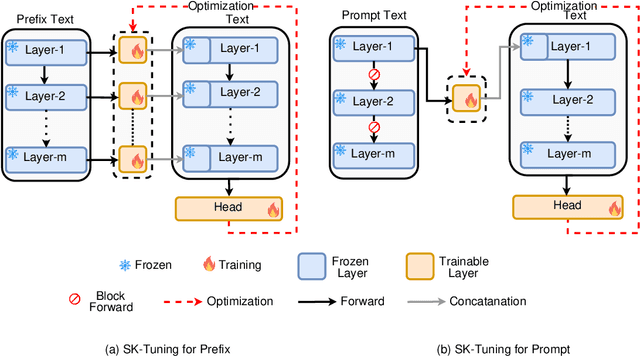
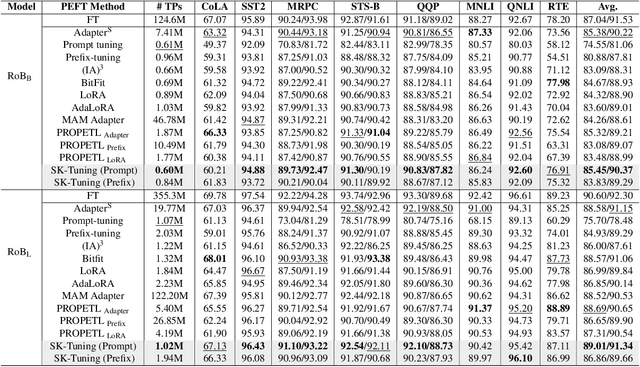
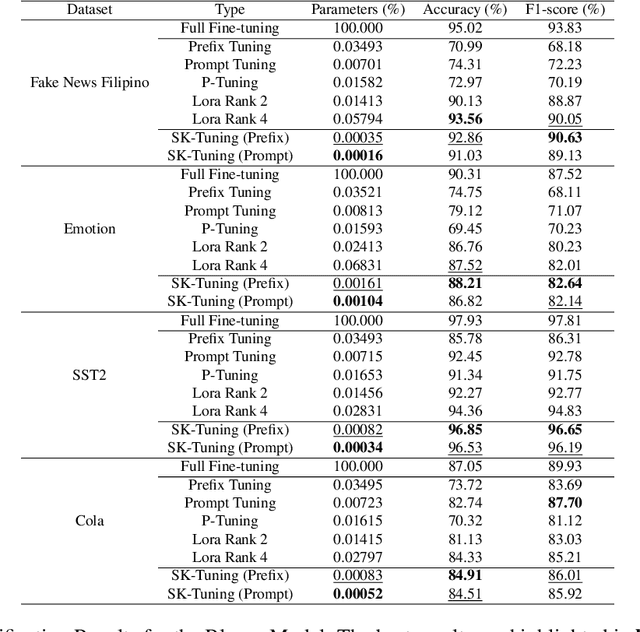
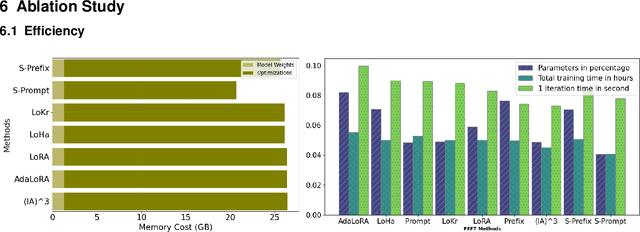
Abstract:Large Language Models (LLMs) are gaining significant popularity in recent years for specialized tasks using prompts due to their low computational cost. Standard methods like prefix tuning utilize special, modifiable tokens that lack semantic meaning and require extensive training for best performance, often falling short. In this context, we propose a novel method called Semantic Knowledge Tuning (SK-Tuning) for prompt and prefix tuning that employs meaningful words instead of random tokens. This method involves using a fixed LLM to understand and process the semantic content of the prompt through zero-shot capabilities. Following this, it integrates the processed prompt with the input text to improve the model's performance on particular tasks. Our experimental results show that SK-Tuning exhibits faster training times, fewer parameters, and superior performance on tasks such as text classification and understanding compared to other tuning methods. This approach offers a promising method for optimizing the efficiency and effectiveness of LLMs in processing language tasks.
FragXsiteDTI: Revealing Responsible Segments in Drug-Target Interaction with Transformer-Driven Interpretation
Nov 04, 2023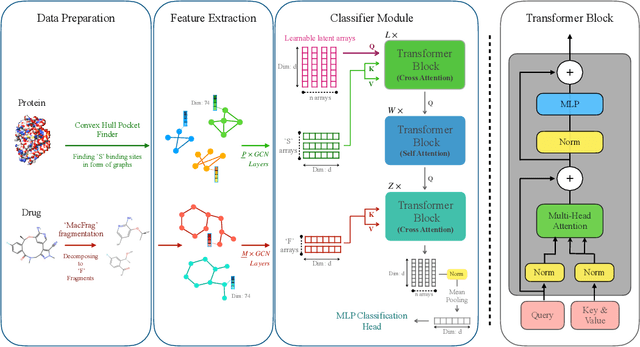
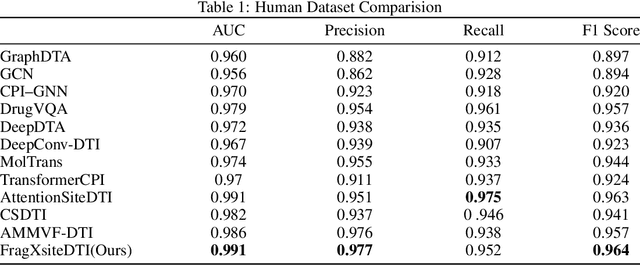

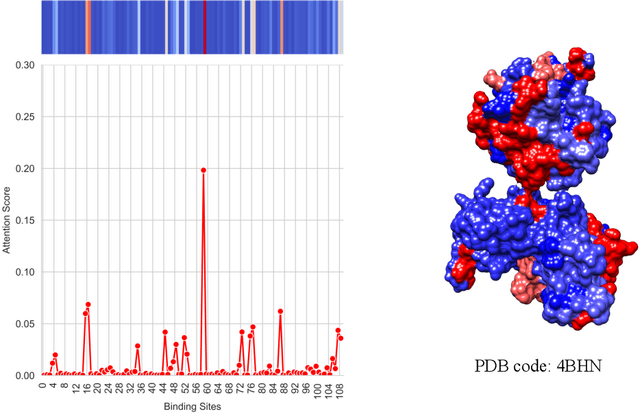
Abstract:Drug-Target Interaction (DTI) prediction is vital for drug discovery, yet challenges persist in achieving model interpretability and optimizing performance. We propose a novel transformer-based model, FragXsiteDTI, that aims to address these challenges in DTI prediction. Notably, FragXsiteDTI is the first DTI model to simultaneously leverage drug molecule fragments and protein pockets. Our information-rich representations for both proteins and drugs offer a detailed perspective on their interaction. Inspired by the Perceiver IO framework, our model features a learnable latent array, initially interacting with protein binding site embeddings using cross-attention and later refined through self-attention and used as a query to the drug fragments in the drug's cross-attention transformer block. This learnable query array serves as a mediator and enables seamless information translation, preserving critical nuances in drug-protein interactions. Our computational results on three benchmarking datasets demonstrate the superior predictive power of our model over several state-of-the-art models. We also show the interpretability of our model in terms of the critical components of both target proteins and drug molecules within drug-target pairs.
Through a fair looking-glass: mitigating bias in image datasets
Sep 18, 2022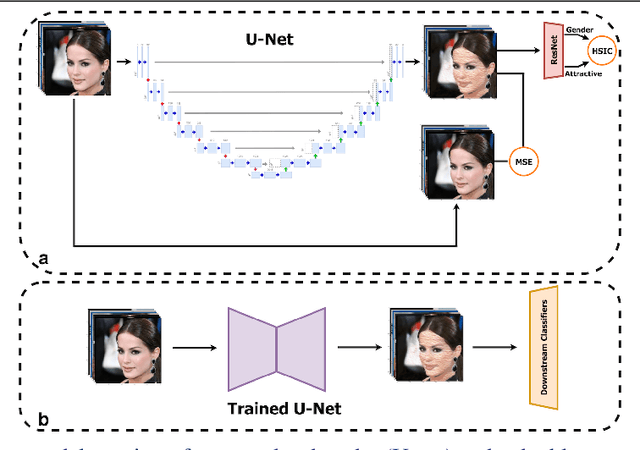



Abstract:With the recent growth in computer vision applications, the question of how fair and unbiased they are has yet to be explored. There is abundant evidence that the bias present in training data is reflected in the models, or even amplified. Many previous methods for image dataset de-biasing, including models based on augmenting datasets, are computationally expensive to implement. In this study, we present a fast and effective model to de-bias an image dataset through reconstruction and minimizing the statistical dependence between intended variables. Our architecture includes a U-net to reconstruct images, combined with a pre-trained classifier which penalizes the statistical dependence between target attribute and the protected attribute. We evaluate our proposed model on CelebA dataset, compare the results with a state-of-the-art de-biasing method, and show that the model achieves a promising fairness-accuracy combination.
 Add to Chrome
Add to Chrome Add to Firefox
Add to Firefox Add to Edge
Add to Edge